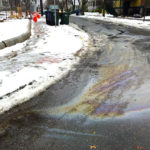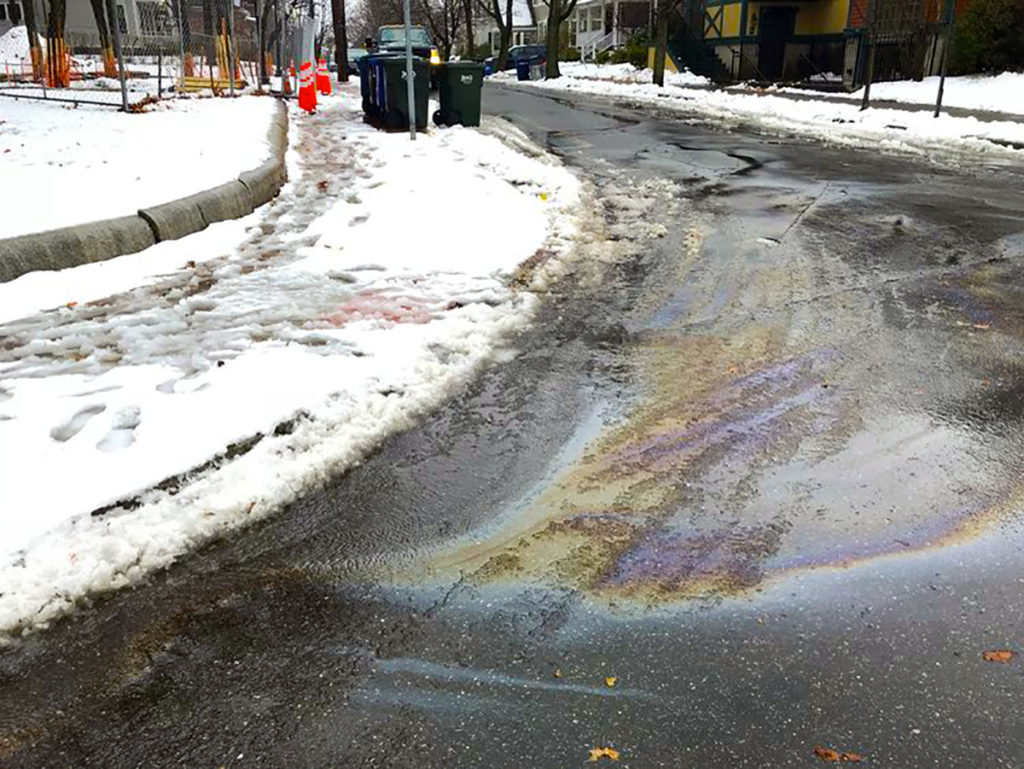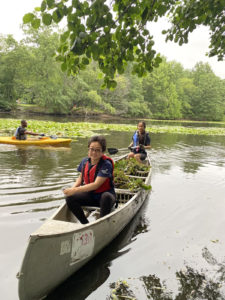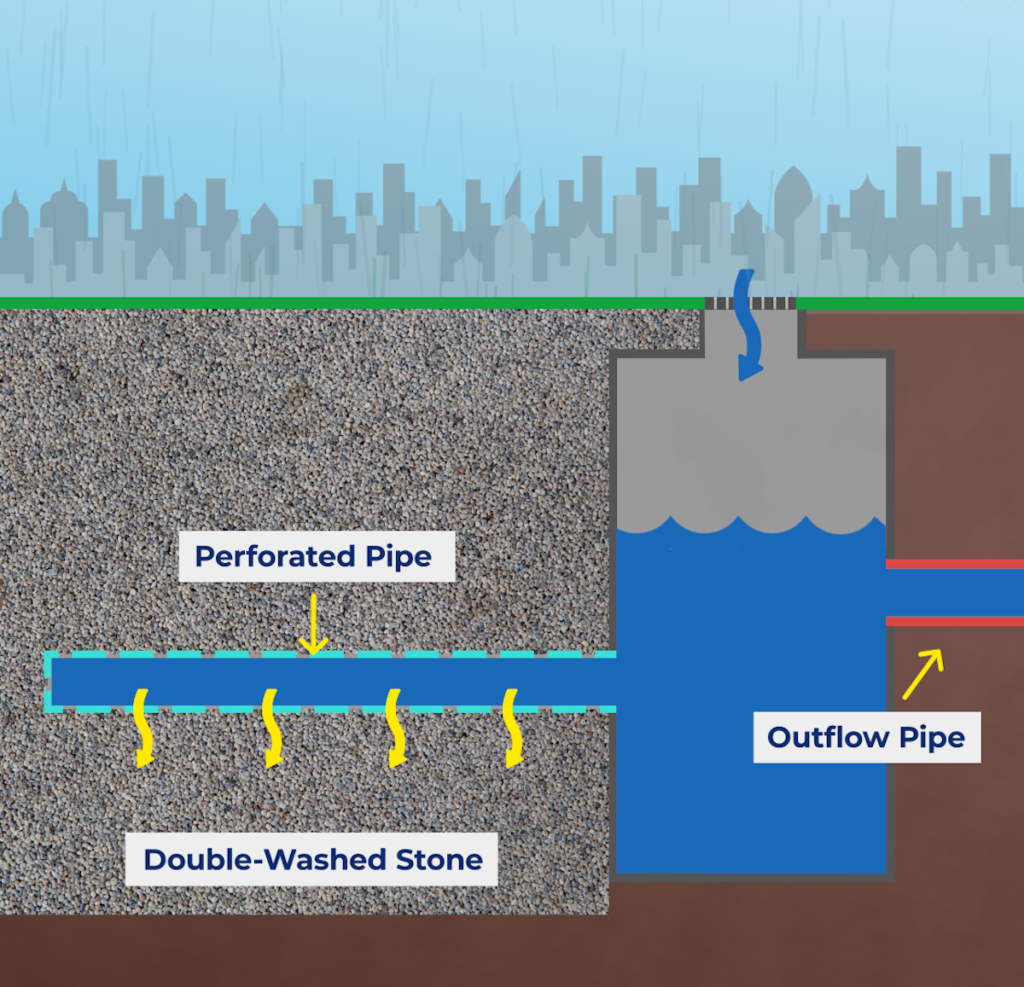
By Michelle Liebtreu and Daria Clark
The Mystic River is cleaner today than it has ever been. The Clean Water Act has been a major environmental success story. But the work is not yet done. As the most urbanized watershed in New England, the Mystic River watershed is especially subject to stormwater pollution, one of the leading sources of pollution in our water today.
Stormwater pollution, also known as stormwater runoff, occurs when rain falls over land—driveways, lawns, and streets—picking up fertilizer, dog waste, salt, leaves, and trash. That polluted water flows into the nearest storm drains and catch basins, discharging through the network of stormwater pipes directly into our rivers, lakes, and ponds —without being treated.

Oil flowing off our local roads during snowmelt, heading untreated to the closest water body. Photo: Mystic River Watershed Association
Many municipalities in our watershed and throughout the Boston area still have combined sewers, which carry both raw sewage and stormwater in a single pipe. During heavy rainstorms the large volume of stormwater can fill these antiquated systems to their capacity. When this happens, the mixture of excess stormwater and sewage is released into the nearest waterway, causing a combined sewer overflow (CSO).
Eliminating many of the CSOs on the Mystic, Charles, and Neponset Rivers, as well as CSOs that emptied directly into Boston Harbor, has helped turn the “dirtiest harbor in America” into “a great American jewel,” as the Boston Globe declared. Although much reduced, annual discharges from CSOs unfortunately still measure in the millions of gallons and happen in all our Boston area watersheds.
In the Mystic River watershed, the CSOs flow in from the Alewife Brook, the Mystic River, and the Chelsea River. The Environmental Protection Agency (EPA) and the Massachusetts Water Resources Authority (MWRA) are working together to improve these systems by separating stormwater and sewage pipes. They are adding features like holding tanks that will minimize and ultimately eliminate the discharge of combined sewer and stormwater. This work is especially important as climate change is causing more heavy rainfalls, which will cause continued and increased CSOs because our current infrastructure can’t handle this flow.
Another great solution is green infrastructure which uses plant or soil systems to mimic natural systems to filter and store water. Examples of green infrastructure include rain gardens, constructed wetlands, or infiltration trenches. The Mystic River Watershed Association (MyRWA) is partnering with municipalities in the watershed to implement these types of solutions. More than 50 infiltration trenches were built in three communities in 2020 alone. An infiltration trench is a relatively new street stormwater innovation that collects rain water from adjacent surfaces and channels the water from the side of the road into permeable soils so that it can quickly seep into the ground.
The standard design for infiltration trenches emerged from workshops led by the US EPA in 2020 via a collaboration between the town of Arlington and the University of New Hampshire Stormwater Center. Municipalities can build these easy-to-deploy retrofits to existing catch basins in a cost-effective manner, and even work them into routine road work.
MyRWA is also working with Lexington, Reading, and Woburn to use green infrastructure to enhance open space, paths and trails, and expand wildlife habitat. These improvements will provide cleaner water by filtering pollutants out of rain and snow melt before they reach the nearest river or stream. They also mimic natural wetlands to provide flood storage during larger rain. Collectively these green infrastructure improvements can markedly improve the water quality and capacity of the watershed.
Because much of the pollutants entering our local water bodies comes from stormwater going directly into your local drains, you can make a difference. From raking up leaves to picking up pet waste to rethinking your lawn maintenance, you can improve local water quality.
Want to do your part? Check out tips to protect clean water, wildlife, and pollinators at www.mysticriver.org/stormwater.
What is Polluting the Mystic River?
Bacteria
The bacteria that MyRWA is most concerned about are pathogens—organisms that cause disease and come from feces. The main source is raw sewage from cracks in our aged sewer lines, pet waste, and CSOs. During periods of heavy rainfall or snowmelt, the amount of rainwater in a combined sewer system can overwhelm the system. In these cases, the combined sewer systems are designed to overflow instead of backing up into houses and streets, and to discharge directly to nearby streams, rivers, or other water bodies. To protect your health, it is best to avoid water bodies for 24 to 48 hours after heavy rain. Want to see if it is safe to boat in the Mystic? See MyRWA’s boating advisory at www.mysticriver.org/boatingadvisory. You can also sign up for CSO alerts at www.mwra.com/updates/everbridge/join.html.
Phosphorus
Phosphorus is a nutrient. Too much phosphorus can cause algae and aquatic plants to grow out of control, causing toxic cyanobacteria blooms. When blooms are present, MyRWA posts on websites and social media. Over the past several years, MyRWA led a major phosphorus study to measure the amount of phosphorus entering the system and the effects it is having on the watershed, in collaboration with US EPA, the Massachusetts Department of Environmental Protection, the United States Geological Survey, and other stakeholders. The “Mystic River Watershed Alternative TMDL Development for Phosphorus Management – Final Report” calls for reducing phosphorus inputs into the Mystic River watershed by 60%.
Trash
Did you know that most of the plastic in the ocean comes from rivers? And that most of the plastic in rivers comes off the land—much of it through the stormwater system? Trash is also the cause of one of the biggest environmental challenges we face worldwide: the huge worldwide growth in the generation of plastic waste and its negative effects on ecosystems and human health.

MyRWA volunteers remove water chestnut, an invasive plant that can take over the river and cause excess nutrients in the water. Photo: Mystic River Watershed Association
Grading Water Quality
The latest EPA 2020 Water Quality Report Card for the Mystic River watershed shows that water quality remains an “A” for the Mystic Lakes, and a “B+” for the main stem of the river.
“This is great news, as it means our urban river continues to be a valuable asset for all our community members to use and enjoy,” said Patrick Herron, MyRWA’s executive director. “The reason we are seeing this grade is thanks to decades of serious investments to clean up Boston Harbor and its rivers, as well as the growing commitment by our municipalities to make local infrastructure improvements.”
But some streams that flow to the Mystic remain seriously impaired. These water bodies—including the Alewife Brook, Winn Brook, and the Little River—have bacteria counts that violate water quality standards much of the time. The cause of this lower grade is bacteria introduced into the watershed by raw sewage which reaches waterways via leaking pipes, illicit connections, and CSOs.
Addressing these issues requires targeted infrastructure improvements. One such tributary, the Island End River, did get that investment, and it paid off. In just three years, the Island End River has gone from earning a “D” for water quality to this year’s grade of an “A+.” After extensive testing and detective work, the city of Chelsea discovered a sewage pipe from a large building that had been installed incorrectly, dumping sewage directly into the creek. This pipe was fixed, and the grade for the tributary has steadily improved.
“The two big takeaways from the report card are 1) go out and enjoy your healthy urban river, and 2) we need to make continued infrastructure improvements to those tributaries that are not meeting the grade,” said Andy Hrycyna, MyRWA watershed scientist. “We don’t have to have failing grades if we invest in policies and infrastructure. The success at Island End shows this.”
Six Things You Can Do to Protect Clean Water
Tips from the Mystic River Watershed Association
- When purchasing plants, opt for native plants or disease or pest-resistant varieties. When you bring them home, be sure to plant them in areas that give them the sun and water requirements they prefer. Happier plants are more pest and disease resistant!
- Don’t overwater! Excess irrigation can wash pollutants down a storm drain. Consider mulch on slopes or even rock barriers or trenches to prevent irrigation flowing into the nearest storm drain, carrying pollutants with it.
- Use mulch! Mulch keeps weeds down, conserves water, and keeps irrigation from flowing out of your yard and into the nearest storm drain. An economical and efficient way to care for your plants!
- Consider replacing your lawn! Swap grass for groundcovers, perennials, and shrubs. Once established, gardens require less fertilizer and pesticides than lawn.
- Plant “pair plants” together. Certain species naturally thrive when planted alongside other certain species. This can help the plants be more pest and disease resistant because they work together to keep each other healthy. For example, plant nasturtiums near your cucumbers as they repel cucumber beetles while also serving as a habitat for predatory insects like spiders and ground beetles. Do some research on pair plants and grow those friends together in your garden.
- Reconsider what is “bad” about weeds. Is crabgrass in your lawn really worth a pesticide application?
Daria Clark is the engagement manager at the Mystic River Watershed Association. Michelle Liebetreu is the Mystic River Watershed Association’s deputy director of external relations.



Sorry, the comment form is closed at this time.